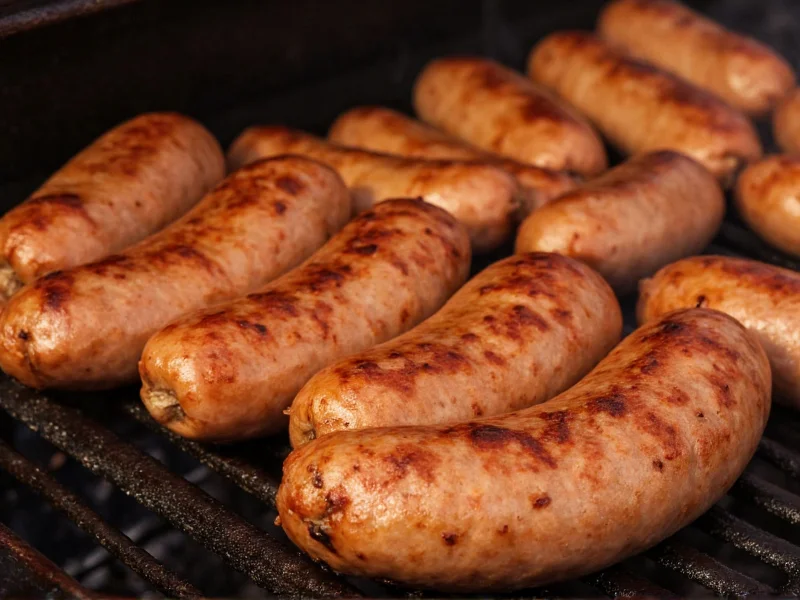Proper cooking temperatures are critical for sausage preparation, directly impacting both food safety and culinary quality. Undercooked sausage poses serious health risks from pathogens like Salmonella, E. coli, and Trichinella, while overcooked sausage becomes dry and unappetizing. This comprehensive guide provides evidence-based temperature guidelines that balance safety with optimal texture and flavor.
The United States Department of Agriculture (USDA) Food Safety and Inspection Service establishes minimum internal temperatures that destroy harmful bacteria in meat products. For sausage cooking, these standards vary slightly based on meat composition. Understanding these differences ensures you achieve food safety without sacrificing quality—a common challenge when learning how to cook sausage properly.
USDA-Approved Sausage Cooking Temperatures
Professional chefs and food safety experts consistently reference USDA guidelines when determining proper sausage cooking temperatures. These standards represent the minimum internal heat required to eliminate dangerous pathogens while preserving moisture and flavor. The critical distinction lies between sausages made from red meats versus poultry.
| Sausage Type | Safe Internal Temperature | Visual Indicators |
|---|---|---|
| Pork, Beef, Lamb Sausages | 160°F (71°C) | No pink color, firm texture, clear juices |
| Chicken, Turkey Sausages | 165°F (74°C) | No pink color, juices run clear, firm texture |
| Pre-cooked Smoked Sausages | 140°F (60°C) | Heated through, steaming hot |
Measuring Temperature Accurately
Many home cooks make critical errors when checking sausage doneness. The most reliable method involves using an instant-read digital thermometer inserted horizontally through the side of the sausage to reach the geometric center—the last area to heat through. Avoid touching the cooking surface or skewer, which gives false readings.
For sausage links, insert the thermometer needle into the thickest part without piercing all the way through. When cooking sausage patties, check multiple spots as thickness often varies. Always clean your thermometer between readings to prevent cross-contamination. Digital thermometers typically provide readings within 3-5 seconds, while dial thermometers require 15-20 seconds for accuracy.
Common Sausage Cooking Mistakes
Understanding proper cook temp sausage techniques prevents several frequent errors. Many people rely solely on color change rather than actual temperature, risking undercooked sausage. Others pierce sausages while cooking, causing precious juices to escape and resulting in dry, tough texture.
The optimal cooking approach involves starting sausages in a cold pan for even heating, then increasing temperature gradually. This technique prevents casing rupture while ensuring thorough cooking. For grilled sausages, use indirect heat initially followed by brief direct heat for browning—this method achieves proper internal temperature without charring the exterior.
Special Considerations for Different Sausage Types
Italian sausage cooking temperature follows the same 160°F standard as other pork varieties, though its higher fat content requires careful monitoring to prevent flare-ups. Breakfast sausage, typically made from pork, also requires 160°F internal temperature despite its smaller size.
Chicken sausage temperature requirements are stricter at 165°F due to poultry's susceptibility to Salmonella. Many home cooks mistakenly treat chicken sausage like pork varieties, creating potential food safety hazards. Always verify with a thermometer, as chicken sausage often appears done before reaching safe temperatures.
Resting and Storage Guidelines
After reaching proper internal temperature, allow sausages to rest for 3-5 minutes before serving. This resting period enables residual heat to distribute evenly and allows juices to redistribute throughout the meat. Never leave cooked sausages at room temperature for more than two hours (one hour if ambient temperature exceeds 90°F).
For leftovers, cool sausages rapidly and refrigerate within two hours. Properly stored cooked sausage remains safe for 3-4 days in the refrigerator or up to four months in the freezer. When reheating, ensure internal temperature reaches 165°F regardless of original cooking method.
Food Safety Beyond Temperature
While proper cook temp sausage practices are essential, comprehensive food safety requires additional precautions. Always use separate cutting boards for raw meats and other ingredients. Wash hands thoroughly after handling raw sausage, and sanitize all surfaces that contact raw meat.
Consider sausage's freshness before cooking—slimy texture, sour odor, or grayish color indicate spoilage regardless of cooking temperature. When purchasing sausage, check expiration dates and ensure proper refrigeration. For homemade sausage, follow strict hygiene protocols during preparation to minimize initial bacterial load.
Frequently Asked Questions
How long does it take to cook sausage to proper temperature?
Cooking time varies by method and sausage size. On the stovetop, standard links typically reach 160°F in 15-20 minutes over medium heat. Larger sausages may require 25-30 minutes. Always verify with a thermometer rather than relying on time alone, as factors like starting temperature and cooking surface affect results.
Can sausage be slightly pink when fully cooked?
Yes, certain sausages may retain a slight pink hue even when properly cooked to 160°F. This occurs due to curing agents like sodium nitrite in many commercial sausages. Always verify with a thermometer rather than relying on color alone, as pinkness doesn't necessarily indicate undercooking in cured products.
What happens if I eat sausage cooked below recommended temperature?
Consuming undercooked sausage risks foodborne illness from pathogens like Salmonella, E. coli, and Trichinella. Symptoms can include nausea, vomiting, diarrhea, and fever, appearing 6-72 hours after consumption. High-risk groups including children, elderly, and immunocompromised individuals face potentially severe complications from undercooked sausage.
How do I check temperature for sausage patties?
For sausage patties, insert the thermometer probe through the side into the center of the patty. Check multiple spots as thickness often varies across the patty. Ensure the probe doesn't touch the cooking surface. Patties typically reach 160°F in 10-15 minutes over medium heat, but always verify with a thermometer rather than estimating by time.
Does sausage temperature differ when using different cooking methods?
The safe internal temperature remains consistent regardless of cooking method—160°F for pork varieties and 165°F for poultry sausages. However, different methods (grilling, pan-frying, baking, boiling) affect how quickly sausages reach proper temperature. Always verify with a thermometer, as exterior appearance can be misleading with various cooking techniques.











 浙公网安备
33010002000092号
浙公网安备
33010002000092号 浙B2-20120091-4
浙B2-20120091-4